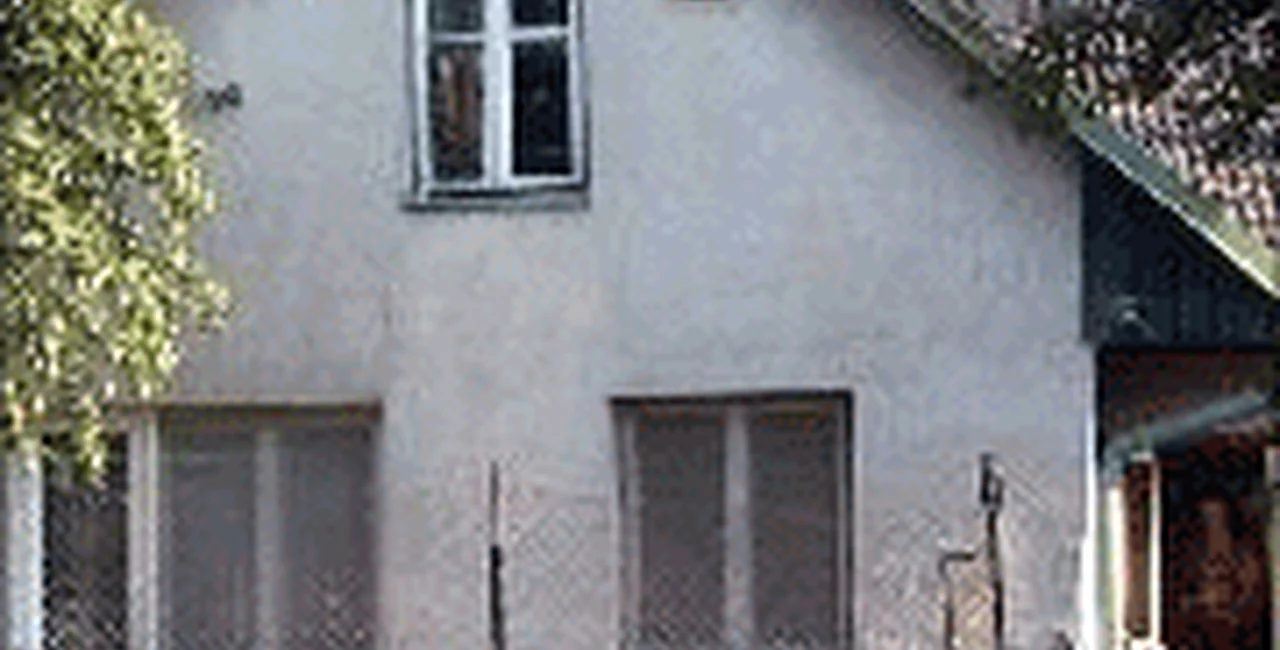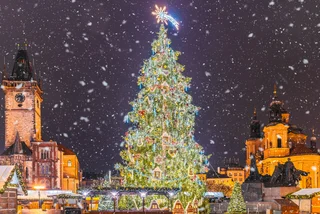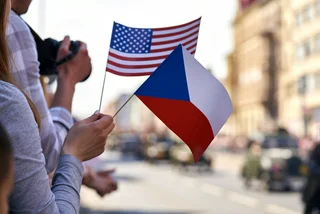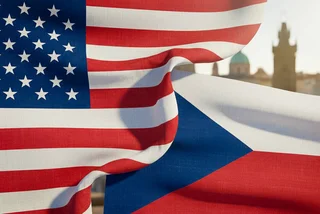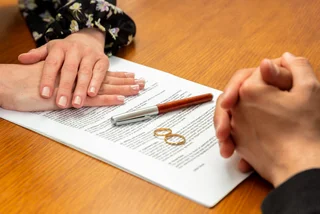Written by Nick Jenkins
for Expats.cz
Zlín is a medium sized town in southern Moravia near the borders with Slovakia and Austria. It owes its claim to fame as the home of Tomáš Baťa a shoemaker who started a factory there with his brother and sister in 1894. In 1914 Baťa got his first big break with an order of 50,000 pairs of shoes for the war effort and from there his empire blossomed. In 1922 the name of Baťa was indelibly inscribed in the annals of podiatry when he halved the price of his shoes and took the world by storm. In the fashion of the day Baťa custom built housing for his workers, starting in 1919 and reaching nearly 700 in 1928. He built the factories, the schools and the hospital as well and the town still feels like a factory city, although most of the heavy industry has moved out. It is nestled in a little valley with wooded hills and steep slopes on all sides. In winter there’s even a modest ski-slope on one hill above town.
The centre of town is still crowded with the old Baťa buildings which are mostly disused, except for one shining example which was renovated in 1970. It was the administrative headquarters of the Baťa empire and was built in 1938 and may have been the tallest office block in central Europe at the time. It’s about sixteen storeys high and features my favourite Czech novelty the ‘paternoster’ (named after the rosary used in the Lord’s Prayer because it resembles a string of beads). It’s a kind of lift-escalator in which cars continuously revolve around a vertical sixteen-storey track and you hitch a ride by jumping on one going in the right direction. It would never get approval in the western world because of Health-and-Safety regulations and the high price of litigation. If you’re more than five feet tall you’ve got to time your entry and exit carefully to avoid collecting an unpleasant smack around the head and possible loss of an extremity or two.
Look and Feel
The architecture here is pretty functional with heavy square shapes dominating the forms. For example the town cinema, built in 1932, looks a bit like a colourless Bunning’s warehouse and behind it lurks the equally rectangular Hotel Moskva from the same era. Sprinkled among the squat oblong buildings are taller tower blocks of pebble-dashed grey cement or orange brick. I suspect the orange brick dates from Baťa’s time and the cement from the communist era and later. The tower blocks house a variety of functions including offices and accommodation and other more unusual things like supermarkets. Shops are often open plan and can be tucked away into the corner of any floor of an office block.
Supermarkets for example can sometimes be found on the second or third floors of office blocks, presumably because these floors are cheaper than the ground floor. How they get the groceries up to the third floor remains a bit of a mystery.
‘Western’ architecture is infiltrating the area with newer purpose built estates springing up and urban sprawl becoming more of a reality. As I speak a new Kaufland supermarket, a German supermarket chain, is going up beside the train and bus stations and they expect to have it finished within a month. Further down the road there are more competing chains with supermarkets from Albert (Dutch), Carre Four (French), SPAR (Dutch), Delvita (Belgian) and Lidl (German).
Industry and Lifestyle
There are about 80,000 souls here in Zlín and the main industry seems to be regional government. They don’t manufacture much of anything here any more and although 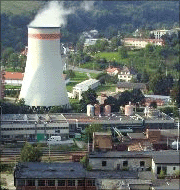 there is some agriculture in the surrounding countryside, most of the people who work there live in smaller villages. For transport most people use public transport in the form of trains, buses or trolley-buses, a cross between a tram and a bus that reminds me of cold-war movies set in Moscow.
there is some agriculture in the surrounding countryside, most of the people who work there live in smaller villages. For transport most people use public transport in the form of trains, buses or trolley-buses, a cross between a tram and a bus that reminds me of cold-war movies set in Moscow.
Living spaces are split between apartment blocks and squarish steep roofed houses built from cinder blocks and rendered in white or ochre tones. I’m livingin a group of modernish apartment blocks in Jižní Svahy or the Southern Hills. The block is about eight storeys high and houses roughly twenty-four families living in two bedroom apartments. The ranks of apartment blocks on Jižní Svahy are far from beautiful but people seem to be comfortable if not actually happy living there.
Many families also have garden plots and zahradní domky, garden houses that they use in summer. My girlfriend’s parents have a garden house fifteen minutes out of Zlín in a small satellite town called Bohuslavice. Their garden house is only 15m2 with its size restricted by local council regulations but into that fifteen square metres however are crammed three floors with all that you might need. The bottom has a cool cellar, laundry and toilet; the middle has the kitchen and living areas; and the top has a sleeping area under the eves and a balcony. I used to thing Australians and English were renovation mad but I think the Czech’s might take the prize.
A little while ago my girlfriend’s parents glassed-in the front porch on the middle level and her dad has just completed a new balcony to open up the front again. To one side of the house is a pergola which covers over a barbecue area and is dripping with white and red grapes from three vines. The barbecue is charcoal and the place has electricity but is on tank water fed from a collective system and not town water. In winter there is no water at all because it freezes in the pipes and visits are usually in the summer. In the garden they grow apples (jabka), little oval plums (švestky), peaches (broskve), cherries (třešně), nut trees, berries, currants, tomatoes (rajčata) and they have a single, very shy little fish in a little pond.
The road up to the garden house is dirt and is so pitted by draining water that we have to decamp from their car at the bottom of the hill so that V’s dad can manoeuvre it up the steep track to their house. The plot of garden houses is fringed by forest and we have cycled or walked to the house from town a couple of times. The area is very hilly and the walk quite strenuous but the forest is lovely and we discovered loads of mushrooms including some edible ones that made a lovely breakfast with scrambled eggs.
In contrast to the town flats, my girlfriend’s great aunt lives out of town in another satellite village called Kostelec-Štípa. She has a tiny little three room house with chickens out the back and some cats for company. The house has electricity but no running water, an outdoor toilet and wood burning stoves for cooking and heating. This in a place where the winter temperatures regularly drop to minus twenty degrees Celsius. My girlfriend’s great aunt also just turned eighty this month. Someone from the family goes round to visit every week and brings her shopping and we’ve been to visit a couple of times. Every time we go we come back with armfuls of zucchinis (cukety), tomatoes, pickled gerkins and eggs, lots of eggs (vejce). It works a bit like a recycling plant, we have to bring the used eggshells back for her chickens.
In a third contrast to the other two styles of living in Zlín, my girlfriend’s grandmother inhabits a two-storey Baťa villa. These villas were built for the workers in the Baťa empire and look rather like square brick town houses. Most are now divided into two, originally four workers families would inhabit one villa or in the case of managers two families. Each has its own little garden and is a comfortable alternative to the tower blocks. From any lookout point, the villas dominate the landscape of Zlín with ranks of cubist red-brick houses laid in a herring bone pattern, like the cobbled streets.
Inside on one wall upstairs my girlfriend’s grandparents have a huge mural of forest in autumn which entirely covers one wall. It’s much better than bland old wall paper and lights up the room when the sun is in the right direction. Every time we go round to visit we are guaranteed to be stuffed full of food regardless of when we last ate or whether or not we’re hungry. This is pretty much par for the course if we visit any relatives except the parents. They all seem to take it as a matter of pride to prove they can feed visitors and to not be able to flop out a stuffed goose to the first person who walks through the door is a calamitous insult.
The People
The people here are friendly… kind of. They are warm and open once you get to know them they are funny people, but no one, and I mean no one, smiles at 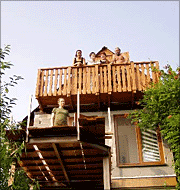 you in the street when you pass them. No one really says hello either but you get the odd polite “dobrý den” (good day) if you’re lucky. People in customer service jobs seem to be particularly afflicted by ill humour and a request for a menu or a bill is usually accompanied by a snarl and a grimace. Just trying to pay for a coffee can be a trial of patience. Conditions for checkout cashiers must also be particularly oppressive since they barely acknowledge your presence in the shops and seem to resent your intrusion into their daily routine. I can usually get a half-sneer or a bare-bones smile when people realise I don’t speak a lot of Czech but I think that’s more out of curiosity than concern.
you in the street when you pass them. No one really says hello either but you get the odd polite “dobrý den” (good day) if you’re lucky. People in customer service jobs seem to be particularly afflicted by ill humour and a request for a menu or a bill is usually accompanied by a snarl and a grimace. Just trying to pay for a coffee can be a trial of patience. Conditions for checkout cashiers must also be particularly oppressive since they barely acknowledge your presence in the shops and seem to resent your intrusion into their daily routine. I can usually get a half-sneer or a bare-bones smile when people realise I don’t speak a lot of Czech but I think that’s more out of curiosity than concern.
One thing you’ll have to get used to while shopping is the habit of not handing over money directly to the cashier but placing it on a small plate by the till. In most shops there will be such a plate beside the till onto which you put the money for your purchase and onto which the cashier will deposit your change. Thrusting it out directly to the cashier is a bit rude and most people find it intrusive. In restaurants (restaurace) and pubs (hospoda) waitresses will carry a purse around their waist and will total up your bill at your table and give you your change on the spot. The bills can seem a bit arbitrary though and some foreigners feel uncomfortable about not getting an itemised bill. Also, if you want to use a toilet you have to be prepared to cough up about 10 crowns for the privilege, hardly expensive and it usually means they’re clean and tidy.
If you visit someone in their home it makes good sense to wear slip-on-slip-off shoes. Most Czech’s leave their shoes at the door and visitors are expected to do the same, trading their street shoes for a pair of slippers. Once inside you should probably practice saying “no” in a loud and confident voice to avoid being stuffed within an inch of your life. Czech families take it as a point of pride to feed visitors with booze and food until they burst. Anything but a firm and consistent “no thank you” will result in a continuous parade of food and constant pressure to consume.
The Food
The food is all quite good but it differs a little from the average calorie conscious diet of western society. The menu which usually consists of something like cabbage soup with bread and lard instead of butter (no I’m not joking), deep fried  cheese with chips and creamy tartar sauce, fat sausage with saurkraut, potato dumplings with slabs of beef (hovězí) or pork (vepřové) and a meat-based sauce called svíčková. For desert you’ll have dumplings with a kind of cream cheese and plum jam or something baked in the oven, stuffed with sweet cheese and covered in poppy seeds. My arteries harden at every meal and I can feel my cholesterol count surge every time I pick up a menu. Czech cuisine is largely untouched by the no-fat, no-sugar, no-salt, no-fun diet that is popular in mainstream western countries. Ice-cream, pastries, doughnuts, cheese, dumplings, pork, hot dogs, sausages and ice cream are all pretty much staples of the Czech diet. Sugar, alcohol, fat and salt all have a special place in the Czech heart, or possibly a little further south in their anatomy.
cheese with chips and creamy tartar sauce, fat sausage with saurkraut, potato dumplings with slabs of beef (hovězí) or pork (vepřové) and a meat-based sauce called svíčková. For desert you’ll have dumplings with a kind of cream cheese and plum jam or something baked in the oven, stuffed with sweet cheese and covered in poppy seeds. My arteries harden at every meal and I can feel my cholesterol count surge every time I pick up a menu. Czech cuisine is largely untouched by the no-fat, no-sugar, no-salt, no-fun diet that is popular in mainstream western countries. Ice-cream, pastries, doughnuts, cheese, dumplings, pork, hot dogs, sausages and ice cream are all pretty much staples of the Czech diet. Sugar, alcohol, fat and salt all have a special place in the Czech heart, or possibly a little further south in their anatomy.
Food from foreign countries is slowly starting to infiltrate the shops with European food easy to find and other varieties coming in through the larger chain supermarkets. Asian food is starting to penetrate the country but with most people preferring bland to spicy food, the uptake is limited. I was delighted to find Thai curry paste and coconut milk in local super market but fresh herbs are limited although you can get as much garlic (česnek) and paprika as you can handle. There’s a large Vietnamese presence in the country but it doesn’t seem to have affected the culture or the cuisine at all. The Vietnamese occupy the status of second class citizens and racism is still endemic in many areas so their influence has been limited.
When it comes to drinking, the beer is good and the white wine is too, the red I would avoid. Beer comes in several flavours or ‘degrees’. The basic stuff is about 10° (which I think refers to the quantity of hops) with the better stuff getting up to 11° or even 12° for beers like Pilsner Urquell from Plzeň, the home of Pilsner beer. The micro-brewery trend of recent years doesn’t seem to have hit here yet but wine production has always been on a small scale in the Czech Republic. If you’re lucky enough to know someone who has a friend with a winery you can arrange some tasting.
I went to a tasting in a winery set up in the long abandoned dungeon of a castle built sometime around the turn of the millennium. The castle itself was long gone by about 1779 when the dungeon was turned into a cellar turning out some very nice whites and some dubious reds. The cellar was about twenty metres long and two wide and turned out exactly one cask for each vintage of the six or seven grape varieties they grew. In southern Moravia it also pays to be wary of their speciality liqueurs like slivovice (plum brandy) and becherovka which is made from a secret recipe of twenty herbs and kicks like a mule. Slivovice is often home made and widely regarded as a cure for everything. Because it’s a clear liquor they say, you can’t get a hangover from it. Ho ho ho…
When I was complaining that I was having difficulty learning Czech to one of my friends from Prague, he advised me to drink some slivovice. After a couple of glasses he said, it would all make sense… or not, it wouldn’t really matter.
The Language
And make no mistake, Czech is a hard language to learn. My text book says it is a Slavic language like Russian and unlike the Romance languages of French, Spanish or Italian. It is also apparently a “synthetic” language where English is an “analytical” language. What this means, I suspect, is that it synthesises words to construe different meanings where English uses constructs built from many words. Czech does this by using suffixes and prefixes and even “infixes” or inserts to words to indicate tense, possession and a host of other things. Now this doesn’t sound too bad but when you throw in an erratic lack of consonants, three genders instead of the two and seven ‘modes of address’ it can leave the poor cizinec (foreigner) not knowing his říť (arse) from his loket (elbow).
The seven modes of address are particularly interesting. They modify nouns, adjectives and pronouns depending on who and what you are talking about. For example the first case, the nominative case is the dictionary form of the word. The second case is the genitive or possessive case and is used similarly to ‘s in English e.g. John’s hair. The third case is the dative or giving which is used when… giving indirect objects. The fourth case is quite common and is the accusative, used where you would point at something and speak about it. The fifth is the vocative, the sixth the locative and the seventh the instrumental case. Couple that with unpronounceable phrases like “strč prst skrz krk” (a joke phrase meaning – stick your finger in your neck) and you have a bit of a linguistic puzzle.
The Czech’s don’t seem to notice this however and feel if they can learn English surely we can pick up a bit of Czech? However I’m finding Czech more of a struggle than French, Spanish, Italian or German and I think it’s probably on par with the Mandarin Chinese I abandoned in high school at age seventeen. As one example, I discovered the other day that when you count in tens you use the suffix “cet” (pronounced ts-et) for 10, 20, 30 and so on up until 50 when you change to “desát”. But for counting in hundreds you use the base sto (100) as a suffix up until 500 when it changes to “set”. What this means to the unwary is that if you say 50 as “pět-cet” (pyet-tset) it actually sounds almost exactly like “pět set” (pyet set) or 500!!! Possibly a costly mistake!
The Heart of Europe
Still the whole Czech experience is proving rewarding, I’m continually surprised (and not to say challenged) by things I discover about a country and people I knew little about before I arrived. The Czechs, more than any other Eastern Bloc country, seemed to have been waiting patiently for their chance at self determination and seem determined now to make the most of it.
I think the Czech Republic has a shining future in Europe. Sure, it has a few hurdles in its way such as a turmoil amongst the fledgling political parties, crises in healthcare and financial troubles in its adoption of the Euro but Europe without the Czech Republic would be like a hug without a squeeze.
Find out more about Nick Jenkins at his website : www.nickjenkins.net/travel












 Reading time: 14 minutes
Reading time: 14 minutes 